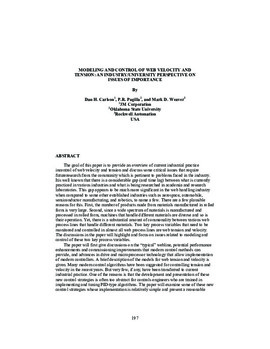| dc.contributor.author | Carlson, Dan H. | |
| dc.contributor.author | Pagilla, P. R. | |
| dc.contributor.author | Weaver, Mark D. | |
| dc.contributor.other | International Conference on Web Handling (2009) | |
| dc.date.accessioned | 2019-11-11T19:52:46Z | |
| dc.date.available | 2019-11-11T19:52:46Z | |
| dc.date.issued | 2009-06 | |
| dc.identifier | oksd_icwh_2009_carlson | |
| dc.identifier.citation | Carlson, D. H., Pagilla, P. R., & Weaver, M. D. (2009, June). Modeling and control of web velocity and tension: An industry/university perspective on issues of importance. Paper presented at the Tenth International Conference on Web Handling (IWEB), Stillwater, OK. | |
| dc.identifier.uri | https://hdl.handle.net/11244/321962 | |
| dc.description.abstract | The goal of this paper is to provide an overview of current industrial practice in control of web velocity and tension and discuss some critical issues that require future research from the community which is pertinent to problems faced in the industry. It is well known that there is a considerable gap (and time lag) between what is currently practiced in various industries and what is being researched in academia and research laboratories. This gap appears to be much more significant in the web handling industry when compared to some other established industries such as aerospace, automobile, semiconductor manufacturing, and robotics, to name a few. There are a few plausible reasons for this. First, the number of products made from materials manufactured in rolled form is very large. Second, since a wide spectrum of materials is manufactured and processed in rolled form, machines that handle different materials are diverse and so is their operation. Yet, there is a substantial amount of commonality between various web process lines that handle different materials. Two key process variables that need to be monitored and controlled in almost all web process lines are web tension and velocity. The discussions in the paper will highlight and focus on issues related to modeling and control of these two key process variables. | |
| dc.description.abstract | The paper will first give discussions on the "typical" webline, potential performance enhancements and commissioning improvements that modern control methods can provide, and advances in drive and microprocessor technology that allow implementation of modern controllers. A brief description of the models for web tension and velocity is given. Many modern control algorithms have been suggested for controlling tension and velocity in the recent years. But very few, if any, have been transferred to current industrial practice. One of the reasons is that the development and presentation of these new control strategies is often too abstract for controls engineers who are trained in implementing and tuning PID-type algorithms. The paper will examine some of these new control strategies whose implementation is relatively simple and present a reasonable level of complexity while providing superior performance to currently used PID techniques. | |
| dc.format | application/pdf | |
| dc.language | en_US | |
| dc.publisher | Oklahoma State University | |
| dc.rights | In the Oklahoma State University Library's institutional repository this paper is made available through the open access principles and the terms of agreement/consent between the author(s) and the publisher. The permission policy on the use, reproduction or distribution of the article falls under fair use for educational, scholarship, and research purposes. Contact Digital Resources and Discovery Services at lib-dls@okstate.edu or 405-744-9161 for further information. | |
| dc.title | Modeling and control of web velocity and tension: An industry/university perspective on issues of importance | |
| osu.filename | oksd_icwh_2009_carlson.pdf | |
| dc.description.department | Mechanical and Aerospace Engineering | |
| dc.type.genre | Conference proceedings | |
| dc.type.material | Text | |
